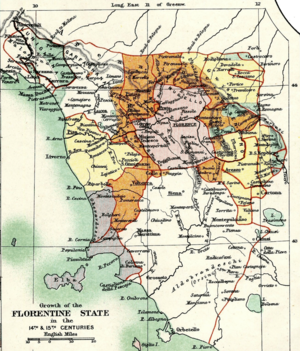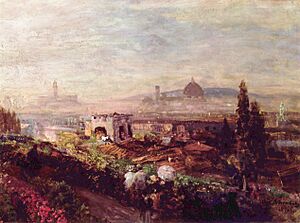History of Florence facts for kids
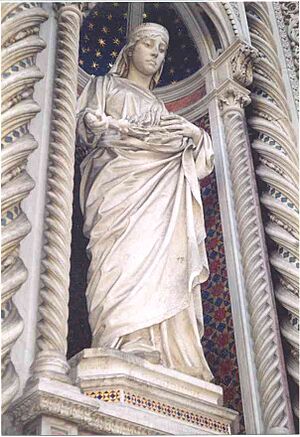
Florence, known as Firenze in Italian, is a famous city in Italy. It survived the fall of the Roman Empire to become a very important center for money and banking in Europe. Powerful families like the Medici family owned banks here. Florence's wealth helped amazing art to grow during the Italian Renaissance. Today, many tourists visit Florence because of its rich history and beautiful art.
Contents
Ancient Beginnings of Florence
For a long time, the area where Florence is now was covered by a huge lake. This was during the Quaternary Age. Even after most of the water dried up, there were still many ponds and marshes. These wet areas remained until the 1700s when the land was finally drained.
People believe that a small settlement existed here between 1000 and 800 BC. This was where the Mugnone River met the River Arno. Later, around 700 to 600 BC, the Etruscans found a good place to cross the Arno River. They probably built a bridge or used a ferry near where the Ponte Vecchio bridge is today. However, the Etruscans preferred to build their main cities on hills for better defense. So, they settled about six kilometers away on a hill, creating the town of Vipsul, which is now Fiesole.
Florence in Roman Times
The written history of Florence usually starts in 59 BC. This is when the Romans founded a village for their army veterans. They named it Florentia, meaning "flowering," because it was built between two rivers. Some stories say the city was founded for military reasons. Julius Caesar wanted a base nearby to watch over important roads.
The Romans built ports on the Arno and Mugnone rivers. This helped with transport and trade. Old Florence was on the Via Cassia, an important Roman road. It controlled the end of a valley and the start of a plain leading to the sea. In AD 123, a bridge was built over the Arno. The Roman settlement grew with an aqueduct, a forum (now Piazza della Repubblica), baths, a theater, and an amphitheater. The shape of the Roman city can still be seen in Florence's street plan today.
Around AD 285, the Roman emperor Diocletian made Florence an important command center. Merchants from the East brought new religions, including Christianity, to the city.
Because Florence grew so much over the centuries, not many Roman buildings are left. You can still see parts of the Roman baths in Piazza della Signoria. The shape of the amphitheater is also visible in the road layout. Many Roman objects are kept in the Florentine National Archaeological Museum.
Early Middle Ages in Florence
Florence became the seat of a bishop around the early 300s CE. For a while, the city was fought over by the Byzantine Empire and the Ostrogothic kingdom. They would capture the city, only to lose it again. This made the city very unstable. By the 500s, the population of Florence was very small, possibly as low as 1,000 people.
Peace returned when the Lombards took control in the 500s. Later, in 774, Charlemagne conquered Florence. It became part of the March of Tuscany, with Lucca as its capital. During this time, Florence's population started to grow again, and trade became successful. In 854, Florence and Fiesole were joined together into one county.
Florence in the Middle Ages
Around 1000 CE, Margrave Hugh "the Great" of Tuscany chose Florence as his home instead of Lucca. This marked the start of a "Golden Age" for Florentine art. New buildings were started, like the Basilica di San Miniato al Monte in 1013. The outside of the baptistry was rebuilt in the Romanesque style between 1059 and 1128.
Florence began a long period of growth starting in the 10th century. From 1115, it was governed by its own independent city-state, called a medieval commune. However, this growth was interrupted by internal fights in the 1200s. The city was divided between two groups: the Ghibellines, who supported the Holy Roman Emperor, and the Guelphs, who supported the Pope. This conflict began after a nobleman was murdered for breaking a marriage promise. The Guelphs eventually won control. But then, the Guelphs themselves split into two groups: the "White" and "Black" factions. These fights led to the exile of the White Guelphs, including the famous poet Dante Alighieri.
Despite these political problems, Florence grew to be one of the most powerful and rich cities in Europe. This was helped by its strong gold money. In 1252, Florence introduced the "florin," a gold coin. It was the first European gold coin made in large enough amounts to be used widely in trade since the 600s. Many Florentine banks had branches all over Europe. Bankers and merchants, like Giovanni Villani of the Peruzzi Company, traded as far away as Bruges. The florin quickly became the most important coin for trade in Western Europe. During this time, Florence also took over its old rival, Pisa, in 1406. Power in Florence shifted from the noble families to the wealthy merchants and members of organized guilds. This happened after a movement led to new laws called the Ordinances of Justice in 1293.
A banker and writer named Giovanni Villani (around 1276–1348) was inspired to write a history of Florence. He started recording the city's history year by year in his book, Nuova Cronica. His brother and nephew continued the book after he died from the Black Death in 1348. Villani's work is important because it saved valuable information about Florence and Europe.
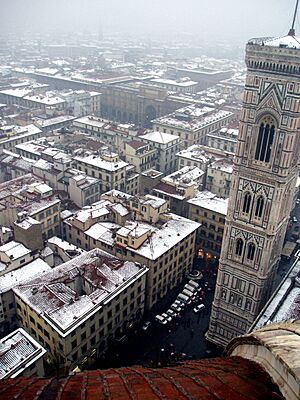
The Renaissance in Florence
In 1338, Florence had about 17,000 people who needed help. About 4,000 received public aid. The city also had six primary schools with 10,000 students, including girls. Four high schools taught 600 students, also including some girls. They studied literature and philosophy.
Before the terrible Black Death plague in 1349, Florence had about 80,000 people. Around 25,000 of them worked in the city's wool industry. In 1345, wool workers tried to strike. In 1378, they started a brief revolt against the city's rulers, known as the Revolt of the Ciompi. After this revolt was stopped, the Albizzi family took control. They were big rivals of the Medici family.
Between 1382 and 1434, the Albizzi family ruled. Then, Cosimo de' Medici (1389–1464) became the first Medici to secretly govern the city. Even though Florence was supposed to be a democracy, Cosimo's power came from his large network of supporters and his political ties to new immigrants. The Medici family also gained importance because they were bankers to the Pope. Cosimo was followed by his son, Piero di Cosimo de' Medici, and then by his grandson, Lorenzo de' Medici, in 1469. Lorenzo de' Medici was a great supporter of the arts. He hired famous artists like Michelangelo, Leonardo da Vinci, and Sandro Botticelli to create works.
After Lorenzo's death in 1492, his son Piero the Unfortunate took over. But his rule was short. In 1494, King Charles VIII of France invaded Italy. Piero made a deal with Charles, which made the Florentines angry. They forced Piero into exile, and the Medici family's first period of rule ended. A republican government was restored. A priest named Girolamo Savonarola strongly influenced the anti-Medici feelings. However, Savonarola lost support and was executed in 1498. The Medici family did not return to power until 1512. The Florentines drove out the Medici a second time and brought back the Republic on May 16, 1527.
A very smart person named Niccolò Machiavelli lived during this time. He wrote about how Florence could be strong under a powerful leader. Machiavelli was exiled from Florence by the Medici family in 1513. This was because he was accused of plotting against them and had ties to the previous republican government. In 1520, the Medici family asked Machiavelli to write the Florentine Histories, a history of the city.

The Siege of Florence (1529–1530) lasted 10 months. It ended the Republic of Florence. Alessandro de' Medici became the city's ruler. The siege destroyed parts of the city, ruined its trade, and took away citizens' wealth. Alessandro was the first Medici to be called "Duke of Florence." This title was arranged for him in 1532 by Holy Roman Emperor Charles V. In 1569, Duke Cosimo I was made "Grand Duke of Tuscany" by Pope Pius V. The Medici family continued to rule Tuscany as grand dukes until 1737.
During the Renaissance in Florence, large groups of people (mobs) were common and had influence. Families often fought each other for power. Political betrayals were common, even within families. Despite the violence and corruption, Renaissance Florence tried different ways for citizens to govern and share power. To help stop the fighting, a complex election system was created. Every few years, officials would secretly vote. The names of those elected were put into bags, one for each of the city's six sections. Every two months, one name was drawn from each bag to form the city's highest government, the Signoria. This system made sure that no two members of the same family were chosen at the same time.
This lottery system organized Florence's political structure until 1434. That's when the Medici family took power. To stay in control, the Medici changed the selection process. They introduced elected committees that they could easily control. Even though civic lotteries still happened, the real power was with the Medicis.
Florence's Role in Art, Literature, and Science
Florence's strong economy, based on money, banking, and trade, helped a great surge in art, literature, and science from the 1300s to the 1500s. People had wealth and time for leisure, which supported these developments.
At the same time, problems within the Catholic church and the terrible effects of the Black Death led people to rethink old values. This resulted in the growth of a humanist culture. Writers like Petrarch and Boccaccio encouraged this. It led to a renewed interest in classical antiquity (ancient Greek and Roman times), which sparked the Renaissance.
This Renaissance flourished in Florence from about 1434 to 1534. It slowed down because of social and political problems. But by then, the new ideas from Florence had spread across Western Europe. Florence greatly benefited from these changes in society. Florentine artists, architects, and musicians became very influential in many parts of Europe. For example, new ideas about ancient Greek plays led to the birth of opera in the 1590s.
Florence in Modern Times

The Medici family line ended in 1737. Francis Stephen, Duke of Lorraine, who was married to Maria Theresa of Austria, then took over. This meant Tuscany became part of the Austrian Empire. Austrian rule ended in 1859 when France and the Kingdom of Sardinia-Piedmont defeated them. Tuscany then became a part of the newly united Kingdom of Italy in 1861.
Florence became Italy's capital city in 1865, replacing Turin. To modernize the city, the old market in the Piazza del Mercato Vecchio and many medieval houses were torn down. They were replaced with a more organized street plan and newer buildings. The Piazza (now Piazza della Repubblica) was made much wider, and a large arch was built. This project was not popular with everyone. A museum nearby today shows what was destroyed. Florence was the capital for only six years before Rome became the capital.
Florence in the 20th Century
In the 1800s, Florence's population doubled to over 230,000 people. In the 1900s, it reached over 450,000. This growth was due to more tourism, trade, financial services, and industry. Many foreign people lived in Florence in the late 1800s. Writers and artists captured a romantic view of the city in their works. Many villas with art collections were given to the city. Today, these are museums like the Horne Museum and the Stibbert Museum.
During World War II, German forces occupied Florence from 1943 to 1944. On September 25, 1943, Allied planes bombed central Florence, destroying buildings and killing 215 people.
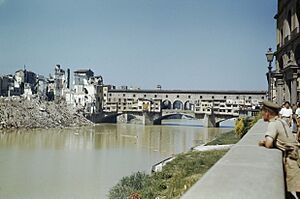
In late July 1944, the British 8th Army approached Florence. New Zealand troops fought to take the hills overlooking the city. After several days, German forces retreated. As they left, Florence was declared an "open city" to prevent further bombing. On August 4, the retreating Germans decided to blow up the bridges over the Arno River. This would make it hard for Allied troops to cross. However, the German officer in charge, Gerhard Wolf, ordered that the Ponte Vecchio bridge be saved. He had been a student in Florence before the war. A memorial plaque on the bridge honors his decision.
At 4:00 AM on August 4, 1944, South African soldiers found the Ponte Vecchio bridge intact. They crossed it under heavy German fire, becoming the first Allied soldiers to enter Florence. Instead of the bridge, an old area of streets south of the bridge was destroyed with mines. Since then, the bridges have been rebuilt to look like their originals. The buildings around the Ponte Vecchio were rebuilt in a mix of old and new styles. Allied soldiers who died fighting in Tuscany are buried in cemeteries outside the city.
On November 4, 1966, the Arno River flooded parts of the city center. At least 40 people died. Millions of art treasures and rare books were damaged. There was no warning from the authorities, except a phone call to the jewelers on the Ponte Vecchio. Volunteers from all over the world came to help save the books and art. This effort led to new ways of art conservation.
On May 28, 1993, a powerful car bomb exploded near the Uffizi museum. It killed five people, injured many others, and badly damaged the museum and its collection. This attack was blamed on the Sicilian Mafia.
Florence in the 21st Century
In 2002, Florence hosted the first European Social Forum. The city is also working on new building and cultural projects. One big project is the Parco della Musica e della Cultura. This will be a large music and cultural center in the Parco delle Cascine (Cascine park). It will have a theater for 2000 people, a concert hall for 1000, a hall with 3000 seats, and an outdoor amphitheater for 3000. It will host many ballets, concerts, operas, and music festivals. The theater opened on April 28, 2011, celebrating 150 years since the Italian unification.
See also
 In Spanish: Historia de Florencia para niños
In Spanish: Historia de Florencia para niños
- Medici
- Republic of Florence
- Grand Duchy of Tuscany
- Timeline of Florence




